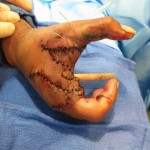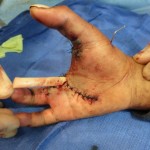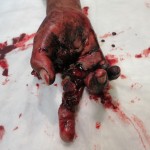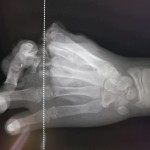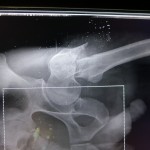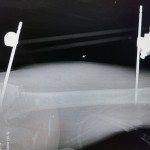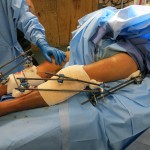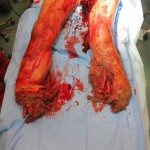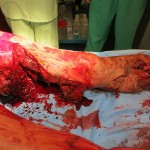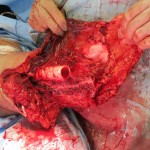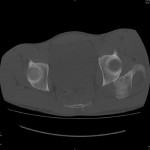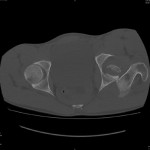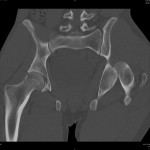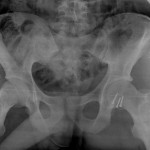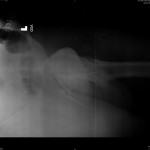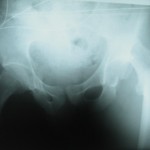Case of the Month – UXO Hand – Part 2 Now Live
Aeromedical evacuation to a higher echelon care facility was not approved for this patient. The surgical team’s first task was to clean and revise her amputations. They removed her index finger metacarpal because it was already fractured near its base and removed about half of her middle finger metacarpal to debulk the closure/flap area.
“We needed to pin her metacarpal fracture but didn’t have a C-arm, so we did the best we could in this deployed austere environment” the surgeon recounted.
Doing what they could without subspecialty availability or modern fluoroscopic imaging, the surgical team then performed a closure with a drain. They made sure the closure wasn’t under tension and Muna Z. could reach the tips of her ring and small fingers with her thumb.
“We tried to do as much as we could for her, seeing how she’ll only have access to very limited care at an Afghan hospital, which is where she’ll be transferred next. We also gave her father a bag of food and some military blankets. The entire surgical team was near tears as the appreciative father spoke to us in translated statements of thanks when his daughter was ready to be discharged from care.”
If Muna Z.’s fracture and soft tissue wounds heal, she should have a functional hand for gripping.
Question:
What other options could be considered for soft tissue coverage of a hand if local coverage is needed?
Case of the Month – UXO Hand – Part 1 Now Live
Twelve-year-old Muna Z. was playing outside her home when a half buried object caught her eye. Always inquisitive, she started to dig up the item to discover what it was. As Muna Z. leaned over to pull the object from the ground, her would-be treasure detonated.
Muna Z.’s father rushed outside when he heard the commotion and saw that the unexploded ordnance (UXO) (i.e., unexploded mine, rocket, mortar, bullet) that triggered his daughter’s curiosity had cost her an eye and part of her right hand.
“Muna Z.’s father sought medical help in the local area, but was turned away. He brought her to our combat support hospital praying that we could do whatever was possible to prevent complete amputation of her hand. We quickly determined she had sustained a traumatic blast amputation of her right index finger, near amputation of her middle finger, and associated fractures of the second and first metacarpal bases. It was apparent that her eye had sustained an open globe injury and could not be salvaged. He cried as he explained his biggest fear was that her hand would be amputated and what that stigma would mean for her future life in the community. Realizing this stigma, as well as the functional activities of daily living (ADL) challenges Muna Z. will now face in her life will be much more difficult with only one hand, we did our best to perform a salvage. While we operated, her father prayed outside on our porch.”
Question:
In this setting, to what lengths should we proceed in order to obtain subspecialty care for this individual? Often the mantra in austere environments is that measures to save “life, limb, or eyesight” qualify patients to receive priority care that may include aeromedical evacuation.
Orthopaedics in Motion – Volume 2, Number 2 – Summer 2012
Orthopaedics in Motion – Volume 2, Number 2 – Summer 2012 is now available online.
Orthopaedics in Motion is a quarterly newsletter containing sections on disaster preparedness and trauma care. The newsletter also includes overviews of the latest aspects of clinic care, continuing education, research and innovation pertinent to the practicing orthopaedic surgeon.
Case of the Month — Spanning Fixation and Proximal Femur
M. Aziz, a 52-year-old male Afghan civilian, sustained a right tibia shaft fracture, a left tibial plateau fracture, and a left subtrochanteric fracture after driving over an improvised explosive device while on his way to visit his brother.
Question: How would you address these closed injuries in an austere environment with only external fixation available for definitive treatment?
“I used external fixation for the right tibial shaft fracture. It was an easy, straightforward procedure,” explained Aziz’s surgeon.
The damage to the left side was more complicated. “I was running low on external fixation connectors, pins, and rods with the case, so I decided to use the distal femur pins in both the left spanning knee fixation and the left hip fixation,” said the surgeon.
As the operating room does not have a fluoroscope, prior to surgery the surgeon places a radio-opaque marker next to a mark he makes on the patient’s skin or next to an entry wound, such as a bullet hole. He then uses images from his own camera to determine where to place the pins based on the relationship of the marker to the patient’s anatomic landmarks.
“One trick I like is to place a flat plate under the hip before the patient is prepped. That way, after inserting the first pin blind with no C-arm, I can take an X-ray and check a plain film to see what adjustments need to be made and where the second pin should be placed in relation to the first. This saves a little bit of time, as we do not have to wait for a plate to be placed.”
In Aziz’s case, the surgeon did not want to place two additional pins in the patient’s femur. He was running low on external fixator pins and wanted to reduce the number of pins placed, since the patient already had multiple pins placed. The surgeon used the same pins in the distal femur for the hip and proximally for the spanning knee fixation.
First, he stabilized the knee so that construct could be used to reduce the hip once the proximal pins were placed. For reduction of the knee, the surgeon pulled in extension, allowing for slight flexion of the knee. He “cheated” valgus a little past what he believed was aligned, as he did not have a C-arm in the operating room and had to use plain films to verify each reduction attempt (these injuries have a tendency to fall into varus), and was successful.
For the hip, the surgeon pulled longitudinal traction distally and “did the opposite of what the proximal fragment wants to do.” He extended, adducted, and internally rotated the proximal fragment to achieve reduction and again, it worked. For a final check, he consulted the X-ray.
“When I do the reductions I tighten one set of connectors and then perform the reduction with my assistant ready to tighten the second set. For the knee I tightened the proximal first and then reduced and tightened the distal. For the hip it was the opposite,” the surgeon explained.
Aziz required no blood products during surgery. Within one hour of the surgery being completed, the dust-off crew medevaced him to a civilian hospital. He was transferred in stable condition.
Case of the Month — Above-Knee Amputation Now Live
Ara K., a 14-year-old girl, along with her sister and cousin, were riding in a civilian bus when it ran over an improvised explosive device (IED). Although the site had recently been discovered and cleared, a new IED had already been replaced in the same location.
All passengers on Ara K.’s side of the bus were injured or killed. Doctors attempted to revive her cousin at the forward operating base, but both he and Ara K.’s sister died.
Ara K. suffered massive damage to both legs. Surgeons performed a below-knee amputation on her right leg, but her left leg was more severely damaged. With skin and soft tissue loss, a below-knee amputation was not feasible for her left leg. Posteriorly, large areas would have had near-exposed bone because there was not enough tissue for coverage.
During hurried discussion, one of her surgeons stated, “If we shunted the left leg, it would have been to a high below-knee amputation [due to the soft tissue damage around the knee] and I don’t know how helpful that would be.”
Surgeons ultimately decided to perform an above-knee amputation. Ara K.’s injuries were so proximal, surgeons obtained control of her femoral artery just proximal to the bifurcation and passed vessels loops around it in case she started to hemorrhage massively from her wounds. Care was taken to keep the tourniquet in place and prep it into the surgical field so that controlled release during surgery could be performed.
Ara K. had damaged and thrombosed vasculature just distal to the level where surgeons made the bony amputation cut. The surgeons had to take more muscle medially in order to debride her injury appropriately. They decided to retain as much viable muscle as possible together with her flap, but in the end had to shorten the femoral cut even more because of concerns that the flap was too thin over the end of the femur. They felt that leaving only viable skin over the distal stump would lead to more complications with eventual prosthesis fitting.
In the operating room, Ara K. was given 1:1 transfusions of fresh frozen plasma and packed red blood cells, and surgeons did not have to use proximal control to stop the bleeding.
Ara K. was maintained for a week at the forward base hospital for stabilization of both her lower extremity injuries and other issues related to the blast. She was ultimately transferred in stable condition to the local hospital for completion of care.
In above knee amputations, what is the utility of myodesis with consideration of future mechanical function and prosthesis fitting?
In rural Afghanistan, like most austere environments, prosthesis fitting is quite difficult. There is a national program that is provided, but the waiting list can be quite long. If NO prosthesis services are available, would that change surgeons’ preferences for amputation level decision making? In this case would you have given the “high below-knee amputation” a chance before converting to an above-knee amputation?
Orthopaedics in Motion – Volume 2, Number 1 – Spring 2012 is now available online.
Orthopaedics in Motion – Volume 2, Number 1 – Spring 2012 is now available online.
Orthopaedics in Motion is a quarterly newsletter containing sections on disaster preparedness and trauma care. The newsletter also includes overviews of the latest aspects of clinic care, continuing education, research and innovation pertinent to the practicing orthopaedic surgeon.
For Orthopaedics in Motion – Volume 1, Number 4 – Winter 2011 please visit The Disaster Preparedness Toolbox and click the Newsletter link.
For Orthopaedics in Motion – Volume 1, Number 3 – Fall 2011 please visit The Disaster Preparedness Toolbox and click the Newsletter link.
For Orthopaedics in Motion – Volume 1, Number 2 – Summer 2011 please visit The Disaster Preparedness Toolbox and click the Newsletter link.
For Orthopaedics in Motion – Volume 1, Number 1 – Spring 2011 please visit The Disaster Preparedness Toolbox and click the Newsletter link.
Case of the Month – Hip Injury – Part 2 Now Live
The surgeon immediately recognized that Spc Walsh had a closed left hip fracture dislocation and without delay attempted a manual closed reduction. Unfortunately, this was not successful, even with the patient under anesthesia. The surgeon then attempted another closed reduction, this time with a Steinmann pin placed in the proximal femur. The fracture, however, was found to be irreducible.
The surgeon decided to perform an open reduction with internal fixation of the Pipkin 2 femoral head fracture.
The patient was then transported by aeromedical evacuation back to his home country where he reportedly went on to complete his healing and recovery without significant complication.
Case of the Month – Hip Injury – Part 1 Now Live
While returning to camp, a small convoy of coalition soldiers traveling in a mine resistant vehicle triggered an improvised explosive device (IED). The vehicle rolled over in the blast, injuring the passengers.
Spc Walsh, a 32-year-old soldier, was treated by a field medic who reported, “The patient was in extreme pain but remained hemodynamically stable.” The medic immobilized Spc Walsh, including his leg, which was in a flexed position, locked in internal rotation. Walsh was then transported, within an hour including flight time, by a medevac helicopter to the nearest level 2 combat hospital.
What would be your initial diagnosis and treatment?
Orthopaedics in Motion – Winter 2012 is now available online
Orthopaedics in Motion – Volume 1, Number 4 – Winter 2012 is now available online.
Orthopaedics in Motion is a quarterly newsletter containing sections on disaster preparedness and trauma care. The newsletter also includes overviews of the latest aspects of clinic care, continuing education, research and innovation pertinent to the practicing orthopaedic surgeon.
For Orthopaedics in Motion – Volume 1, Number 3 – Fall 2011 please visit The Disaster Preparedness Toolbox and click the Newsletter link.
For Orthopaedics in Motion – Volume 1, Number 2 – Summer 2011 please visit The Disaster Preparedness Toolbox and click the Newsletter link.
For Orthopaedics in Motion – Volume 1, Number 1 – Spring 2011 please visit The Disaster Preparedness Toolbox and click the Newsletter link.

